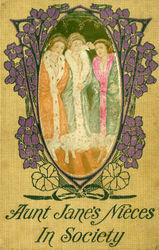Aunt Jane's Nieces in Society facts for kids

First edition
|
|
| Author | L. Frank Baum (as "Edith Van Dyne") |
|---|---|
| Illustrator | Emile A. Nelson |
| Country | United States |
| Language | English |
| Genre | Young adult fiction Crime fiction Satire |
| Publisher | Reilly & Britton |
|
Publication date
|
1910 |
| Media type | Print (hardcover) |
| Pages | 264 pp. |
| Preceded by | Aunt Jane's Nieces at Work |
| Followed by | Aunt Jane's Nieces and Uncle John |
Aunt Jane's Nieces in Society is a novel for young readers written by L. Frank Baum. He is famous for creating the magical Land of Oz. This book was first published in 1910.
It is the fifth book in the Aunt Jane's Nieces series. This series was Baum's second most popular work, right after his Oz books. The story continues to follow the adventures of three cousins: Louise Merrick, Beth De Graf, and Patsy Doyle. It also features their family and friends. Like other books in the series, it was published under the pen name "Edith Van Dyne." A pen name is a fake name an author uses.
What the Story is About
This book explores a favorite idea of L. Frank Baum. It looks at how empty and fake a very fancy, high-class life can be. In many of Baum's books, especially the Oz stories and the Aunt Jane's Nieces series, he shows that being simple and natural is better than trying to be overly "sophisticated." Sophisticated means trying to seem very fancy or worldly.
The characters in the book often question the idea of "high society." Patsy, one of the cousins, believes that all good people are part of society. She thinks some groups have separated themselves from others. They only let in people who are just like them. Patsy feels that these people put themselves on a pedestal. Yet, others look up to them and seem happy to do so.
Beth, another cousin, at first really dislikes the idea of high society. Her cousin Louise even calls her a "strong critic" of it.
The Story's Plot
The story starts with Uncle John, who takes care of the cousins, and Louise's mother. Louise's mother thinks the girls are missing out by not being part of "Fashionable Society." Uncle John knows his sister-in-law can be a bit silly. But her words make him worry. He doesn't want his nieces to miss out on anything good in life.
Uncle John uses a business connection with Hedrik Von Taer. Mr. Von Taer is a very important person in New York City's social scene. Uncle John asks Mr. Von Taer's daughter, Diana Von Taer, to help the nieces enter society. Diana knows Uncle John is very rich and important to her father's business. So, she agrees to help, as long as the girls aren't "impossible."
Diana visits each cousin. She is impressed by Louise's kindness and classic style. She likes Patsy's lively spirit. She also notices Beth's beauty, even though Diana and Beth don't get along at first. Diana decides the girls are acceptable. She helps them make their first appearance in society. Everything goes well. The cousins quickly become part of the social scene. Soon, they are even managing the flower booth at a big charity ball.
Things get complicated when Arthur Weldon shows up. He is Louise's on-again, off-again boyfriend from earlier books. Arthur has been spending time with Diana Von Taer. But when he sees Louise again, his feelings for her return. This makes Diana very jealous. Diana asks her cousin, Charles Connoldy Mershone, to try and win Louise's attention. Charles is a bit of a troublemaker and not well-liked in society. Diana hopes this will break up Louise and Arthur.
Diana doesn't expect Mershone to actually fall in love with Louise. But he does. When Louise chooses Arthur instead of him, Mershone does something extreme. He takes Louise away and keeps her at Diana's country house. This house is in East Orange, New Jersey, which was a quiet, country area back then.
When Louise goes missing, her family and Arthur call the police. They also hire private detectives. One detective, Quintus Fogerty, is known as "the best man in all New York." Mershone is the main suspect. But he is clever and doesn't reveal where Louise is. This part of the story shows a tougher side of the social world.
Louise is very surprised and confused when she is taken. But after five days, she feels strong enough to escape. During a big snowstorm, she climbs out a window and down a vine. The storm makes her weak, but a passing farm couple rescues her. Arthur Weldon finds Louise at the farmer's house, and they are very happy to be together again.
Louise's family decides not to get Mershone in trouble with the law. They want to avoid a big newspaper scandal. They also don't want the "doubtful satisfaction" of revenge. The story ends with a very fancy wedding for Arthur Weldon and Louise Merrick. In the end, even Beth changes her mind about high society.
Beth says, "Society is a good idea in general. Of course, it has its bad people. But I think it's no more than any other group of people."
"Oh my!" Uncle John exclaims, "You once spoke badly about society!"
"That," she replies, "was before I knew anything about it."
The Detective
L. Frank Baum introduces the character of the private detective Quintus Fogerty in this book. This character appears again in a later book in the series, Aunt Jane's Nieces on Vacation. Fogerty's job is to help the girls when they get into difficult situations. He helps solve problems and mysteries in the story.
Images for kids
See Also


